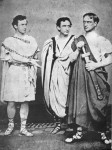 Descendants of renowned Shakespearean actor Edwin Booth want to exhume his body so that his DNA can be compared to the DNA from the remains of the man who died in the Garrett farm barn after being shot by federal troops chasing the assassins of President Abraham Lincoln. Why, you ask? To confirm that John Wilkes Booth is buried in John Wilkes Booth’s grave.
Descendants of renowned Shakespearean actor Edwin Booth want to exhume his body so that his DNA can be compared to the DNA from the remains of the man who died in the Garrett farm barn after being shot by federal troops chasing the assassins of President Abraham Lincoln. Why, you ask? To confirm that John Wilkes Booth is buried in John Wilkes Booth’s grave.
We know the man who died in a barn as John Wilkes Booth, presidential assassin, Edwin’s brother and a far less successful actor, but a conspiracy theory posits that John Wilkes Booth never died in the barn, that the man buried in Wilkes’ grave was someone else entirely who was just bringing Booth his papers only to get killed by federales in the Garrett barn. Wilkes, this theory has it, escaped West changing his name multiple times and ultimately dying by his own hand (he took strychnine) in Oklahoma in 1903.
One of Edwin Booth’s descendants, Joanne Hulme, was told by her mother that it was a family secret that Wilkes had escaped, but the main source of the story is a book published in 1907 by lawyer Finis Bates. In The Escape and Suicide of John Wilkes Booth : or, The First True Account of Lincoln’s Assassination, Containing a Complete Confession by Booth, Bates described meeting a man named John St. Helen in Texas in 1873. Although a tobacco merchant, St. Helen was adept at reciting Shakespeare, and one time when he thought he was going to die, he confessed his secret. Later he filled in all kinds of detail, like that the leader of the conspiracy was none other than Vice President Andrew Johnson himself.
 St. Helen and Bates parted ways shortly thereafter, but when one David E. George died in Enid, Oklahoma in 1903, papers on him asked that Finis Bates be notified. When he arrived, he recognized the arsenic-embalmed body as that of his old friend John St. Helen. (The corpse would go on to have a far more successful entertainment career on the sideshow circuit than John Wilkes had ever had in the theater.)
St. Helen and Bates parted ways shortly thereafter, but when one David E. George died in Enid, Oklahoma in 1903, papers on him asked that Finis Bates be notified. When he arrived, he recognized the arsenic-embalmed body as that of his old friend John St. Helen. (The corpse would go on to have a far more successful entertainment career on the sideshow circuit than John Wilkes had ever had in the theater.)
Bates says in the book that he didn’t believe St. Helen’s confession at first, but there is a record of him writing to the War Department in 1900 offering to deliver Lincoln’s assassin alive if they’d pay him the $100,000 reward they posted in 1865. Since that reward had already been paid to the men who trapped Booth in the barn, the War Department declined.
The book was roundly ridiculed when it was published, but various versions of the wrong body theory have continued to spread, including on shady History Channel “documentaries.” In 1995, another of Edwin Booth’s descendants Lois Trebisacci asked to exhume Wilkes’ body to put the question to rest once and for all.
In 1995, a judge in Baltimore denied her request to exhume the remains of the man believed to be John Wilkes Booth in an effort to confirm his identity, her attorney, Mark Zaid of Washington, said yesterday. He said the cemetery objected to an exhumation, even though he had secured permission from 26 living relatives.
“The family was as much interested in disproving [the escape] theory as they were in proving it,” he said by phone.
Since that avenue is closed off, the interested parties now want to go about it in a roundabout way: by exhuming Edwin Booth’s body and comparing the DNA to bone fragments from the barn assassin preserved at the National Museum of Health and Medicine in Washington, D.C. and the Mutter Museum in Philadelphia.
The family’s attorney Mark Zaid plans to file an exhumation request for Edwin’s body, interred in Mount Auburn Cemetery in Cambridge, early this year.